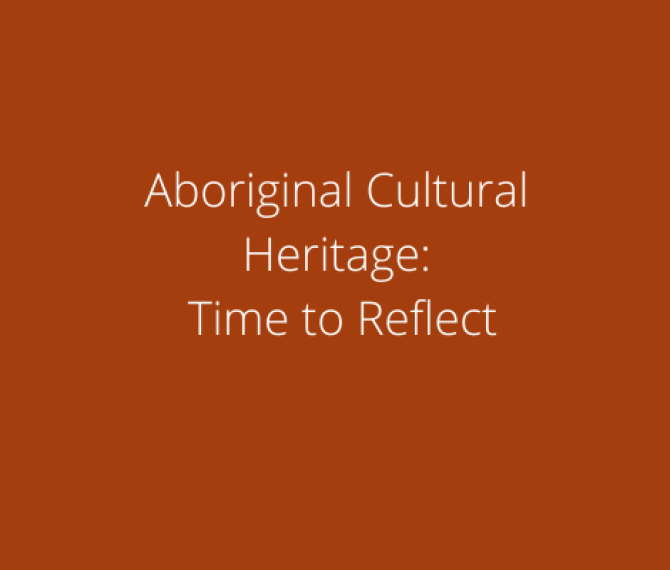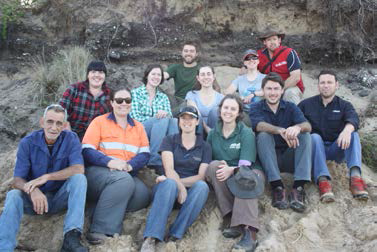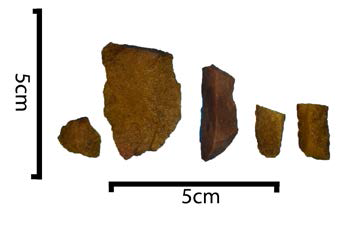Aboriginal Cultural Heritage: Time to Reflect
In 2006, the Victorian Parliament passed a major piece of legislation which strengthened protection of Aboriginal cultural heritage and ensured broader compliance with protection measures. The Victorian Aboriginal Heritage Act 2006 (AHA 2006) marked an important moment in the reconciliation movement because the legislation was, at the time, seen to be arguably the strongest of its kind.
Although the Victorian legislation borrowed heavily from the Queensland Aboriginal Heritage Act 2003, the Victorian version was noticeably different in its strict, prescriptive application with regard to the types of assessments required to achieve approval. It remains the strongest indigenous heritage legislation across all Australian states, and notably, a five year review by the State Government has just been completed with the passing of the Aboriginal Heritage Amendment Bill in February 2016. We now look at how the AHA 2006 has performed in its ten years of operation, highlighting its greatest achievements and deficiencies, with particular reference to its role in the Victorian planning system.
The AHA 2006 was conceived amid recognition of two major issues affecting the Victorian development environment in terms of heritage management. The first issue surrounded the relative uncertainty of undertaking developments under existing indigenous heritage requirements. The second issue concerned the need to advance reconciliation in Victoria and transfer authority in Aboriginal cultural heritage management from the State into the hands of recognised traditional owners.
Prior to 2006, the protection of indigenous heritage was governed under the Archaeological and Aboriginal Relics Preservation Act 1972. The legislation afforded protection to indigenous heritage, but was not prescriptive in terms of how an assessment of the nature and significance of sites and places was to take place. Frequently, there was a superficial examination of a site’s potential to contain cultural heritage and significance, and mitigation measures often relied on a program of monitoring during the construction phase of a project. In practice, this system worked in favour of developers most of the time. However, occasionally, when significant indigenous heritage was discovered during construction, there were substantial time and cost implications for developers. In terms of outcomes for indigenous heritage, they were generally poor. Artefacts were normally recovered out of their original context, which did not improve our overall understanding of past Aboriginal land use and cultural practices within sites.

A related issue plaguing the previous system was the nature of traditional owner involvement in investigations, and the authority accorded to the traditional owner groups. Traditional owners across Victoria operated out of community centres or cooperatives, which had little effective authority. Members negotiated with developers for certain outcomes and were able to issue consents to disturb certain sites. A troublesome consequence of the system was the wildly different and inconsistent management of heritage across the State. Disenfranchisement of some traditional owners not connected to the cooperatives holding authority to issue consents also increased.
Group: Positive outcomes for indigenous cultural heritage often arise from collaborative efforts such as the Browns Creek Midden Archaeological Project – an AV, La Trobe University, Biosis, Otways Land Care, Coastal Care, Eastern Maar Aboriginal Corporation and Guli-Gad initiative.
Critical improvements made
The AHA 2006 and the Aboriginal Heritage Regulations 2007 (AHR 2007) made critical improvements to the previous system’s issues. First, the new AHA 2006 and AHR 2007 introduced prescriptive guidelines on assessments necessary to achieve approvals through the Cultural Heritage Management Plan (CHMP) process. Importantly, the CHMP process was moved to the front of approval schedules so that planning applications could only be submitted once a CHMP was approved, if one was required. The impact of the front ended nature of the CHMP was to provide greater clarity and certainty to developers when planning a development and also ensure that, at least theoretically, the cultural heritage considerations could not be overlooked within the planning application process.
The second major improvement of the AHA 2006 surrounded the appointment of Registered Aboriginal Parties (RAPs) to areas where traditional owners were able to demonstrate continuous and historical links to country. The RAPs were to act as representative bodies for traditional owners in their areas of jurisdiction and issue approvals over CHMPs. Importantly, this allowed traditional owners greater power and direction over the management of their cultural heritage.The improvements brought in by the new system were felt almost immediately, but it was not without its problems. First,the prescriptive nature of the new legislation encouraged some to take a quite literal interpretation of the AHR 2007. In the early days of the new AHA 2006, proponents were required to undertake levels of assessments that were excessive to the extent that some projects were no longer viable financially.The literal tendency has subsided through time so that the interpretation of the requirements for CHMP assessments is now relatively well understood and workable.
At LGA level, consideration of the triggers for a mandatory CHMP has been inconsistently applied. Several Red Dot VCAT decision have resulted from the uncertainty of determining exemptions from mandatory CHMPs on the basis of previous significant ground disturbance (SGD).
A further issue connected with the AHA 2006 surrounded the appointment of RAPs. Today approximately 50% of Victoria is represented by RAPs. The other 50% is administered by Aboriginal Victoria (AV) formerly the Office of Aboriginal Affairs Victoria. Although the RAP system overall is considered a successful initiative, there are considerable challenges. The displacement of Victorian indigenous people historically has meant that for some, demonstrating traditional links to country is not possible. For others, displacement has meant that from colonial times, they and their ancestors have lived in areas that they are not considered the traditional owners for. This has meant that some areas of Victoria will always struggle to appoint a RAP. It also means that some traditional owners will always be marginalised by the new system and struggle to have a voice. It must be agreed that this is a distinct failing of the new system. Finally, with regard outcomes for cultural heritage, stakeholders are divided over whether the new system has improved the situation. RAPs differ in terms of their interpretation of the AHR 2007 and in their understanding of cultural heritage significance. The AHA 2006 is not prescriptive about determining significance levels and hence there is wide disagreement over significance of sites respectively betweenRAPs, RAPs and AV, and RAPs, AV and cultural heritage advisors. This issue has cast doubt on whether there are better net outcomes for cultural heritage as a result of the AHA 2006 from development impacts.
Five years of operation enabled all stakeholders participating in the new system to provide feedback and suggestion as part ofthe review of the AHA 2006. The review was undertaken between 2011 and 2015, and is now complete, with the amendment bill draft now having passed through both houses of parliament with very minor amendments. The AHR 2007 are currently beingrewritten with an aim to deliver in early August 2016.
The review process included several rounds of consultation through a discussion paper, issues and options paper, socioeconomic benefits study, an inquiry into the effectiveness of RAPs, and a State Government response. A number of issues were raised by different sectors including developers, LGAs, RAPs and traditional owners, cultural heritage advisors and professional bodies. Principal concerns included greater certainty for proponents grappling with statutory triggers for a CHMP; greater control over RAPs’ demands during the CHMP stage of work and their fees; improved efficiencies for processing CHMPs; better compliance mechanisms including enforcement; and greater involvement of traditional owners in the overall process including improved resourcing of RAPs.
Silcrete artefacts: Aboriginal stone artefacts – a ubiquitous artefact type across Victoria.
As with most legislative reviews, the result has been relatively balanced, which means that many stakeholders feel shortchanged.But there have been noticeable improvements through a number of areas. Highlights of the AHA 2006 Review include:
- Introducing certainty through the formulation of the Preliminary Aboriginal Heritage Test, which will enable proponents to seek advice from the Secretary and remove the uncertainty of dealing with LGAs on the question of whether a CHMP is required
- CHMPs will be subject to a ‘stop the clock’ mechanism and minor amendment opportunities within a five-year period of approval if required
- Greater powers have been granted to RAPs with a new ability to approve cultural heritage permits and act as enforcement officers
- Recognition of marginalised traditional owners with the state allocating resourcing to assisting proponents in consultation when there is no RAP for a project area
- Compliance issues with CHMPs have been recognized – AV has instituted a new compliance unit, which is already in operation.
The above items represent a snapshot of the Amendment Bill,ratified in Parliament, which has strengthened the existing act and made notable improvements to its operations. Further changes, perhaps even more important for proponents, will be introduced through the AHR 2007 review which is underway.The latter may include changes to the high impact activity threshold of three-lot subdivisions; accreditation of cultural heritage advisors in order to raise the overall quality of cultural heritage work; and the introduction of a levy/contribution to assist in the resourcing of RAPs.
The AHR 2007 review, scheduled to be completed by early August 2016, will provide a further opportunity to examine improvements and changes to the current system. From the point of view of this author, the current system has been a notable improvement from the previous legislation, providing greater certainty and clarity for all. While there are problems and disagreements governing the operation of the AHA 2006,the issues are diminishing with time as all stakeholders become better educated in the system. The recent review, whilst notable to appease all interested parties comprehensively, has done a reasonable job of making minor changes to improve a generally well-functioning system.
Important links
Aboriginal Heritage Act 2006
This article was featured in the May 2016 edition of Planning News and is Copyright © 2015 by Planning News, PIA Victorian Division. All rights reserved.








